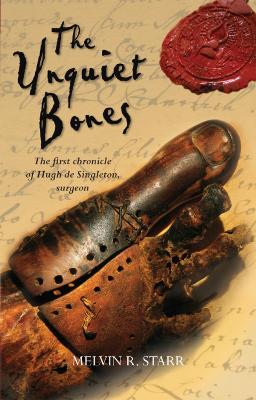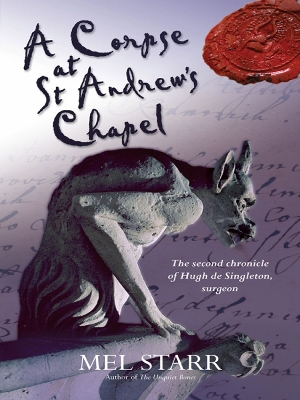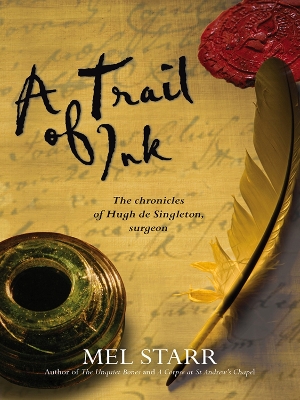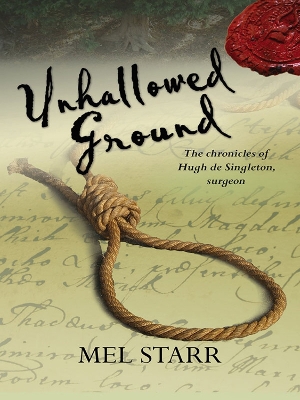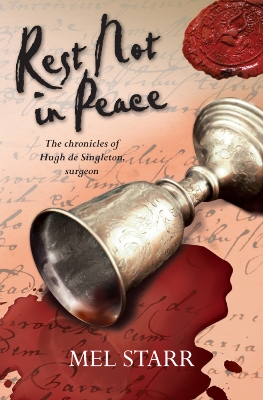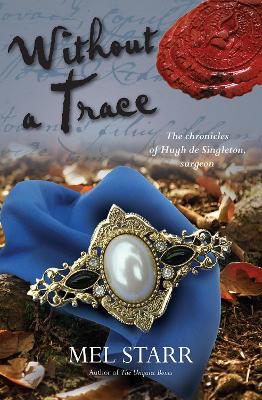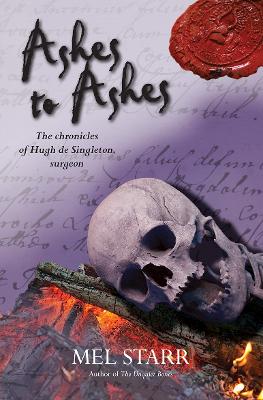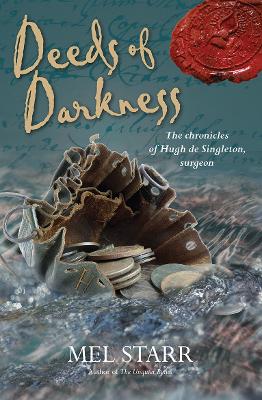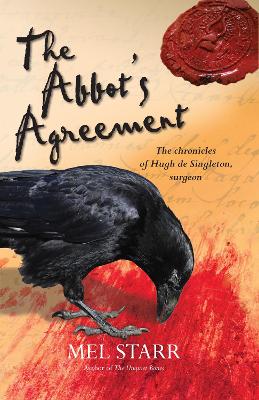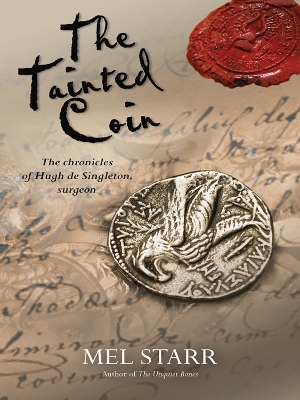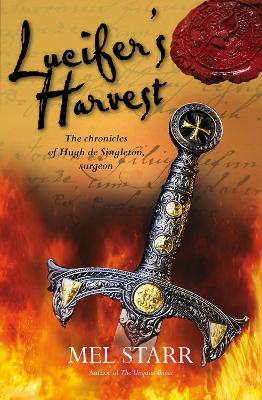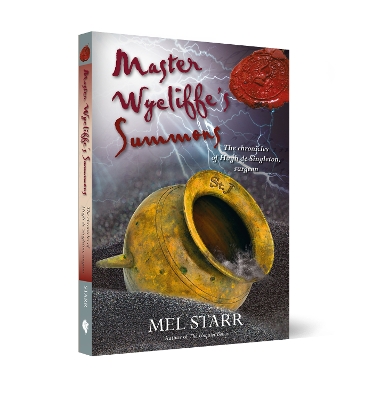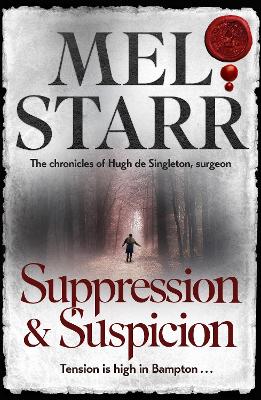The Chronicles of Hugh de Singleton, Surgeon
6 primary works • 17 total works
Book 1
Book 2
Book 3
He told me later, when I had returned them to him, that it was as onerous to plunder a bachelor scholar's books as it would be to steal another man's wife.
I had, at the time, no way to assess the accuracy of that opinion, for I had no wife and few books ...'
So begins another delightful and intriguing tale from the life of Hugh de Singleton, surgeon in the medieval village of Bampton, near Oxford, and bailiff of Bampton Castle at the behest of Lord Gilbert Talbot.
Hugh sets his cap at the delightful Kate, who proves equally resourceful in the search for the missing books. Some very determined adversaries are out to stop him, permanently if necessary - but are they motivated by greed or a more personal animosity? Then the corpse of a poor scholar, who had tried to sell one of the books, is found in the river: but he had not simply drowned ...
Book 4
Thomas atte Bridge, a man no one likes, is found hanging from a tree near Cow-leys Corner. All assume he has taken his own life, but Master Hugh and Kate find evidence that this may not be so.
Many of the town had been harmed by Thomas, and Hugh is not eager to send one of them to the gallows. Then he discovers that the priest John Kellet, atte Bridge's partner in crime in A CORPSE AT ST. ANDREW'S CHAPEL, was covertly in Bampton at the time atte Bridge died.
Master Hugh is convinced that Kellet has murdered atte Bridge ' one rogue slaughtering another. He sets out for Exeter, where Kellet now works. But there he discovers that the priest is an emaciated skeleton of a man, who mourns the folly of his past life. Hugh must return to Bampton and discover which of his friends has murdered his enemy...
'Mel Starr has given us another layered, compelling mystery, strong with abundant, telling details of everyday medieval life. This is a series well worth the reading.' Margaret Frazer, author of the Dame Frevisse medieval mysteries
Book 6
"None... but that the man was robust one day and a corpse the next."
Master Hugh, surgeon and bailiff, has been asked to provide a sleeping potion for Sir Henry Burley, a friend and guest of Lord Gilbert at Bampton Castle, near Oxford. Three days before St John's Day, in the year of our Lord 1368, Sir Henry went to his bed hale and hearty after enjoying a long evening music, conversation, and dancing in Bampton's Castle's hall. The next morn his valet found him cole and dead.
Master Hugh is asked by Lord Gilbert to determine the cause of death - despite shrill accusations from Sir Henry's grieving widow...
Book 12
Lady Philippa, the wife of Sir Aymer - a knight of the realm - disappears while travelling from her husband's manor to Bampton. They have simply vanished. As the disappearance may have happened while they were traveling on Lord Gilbert's lands, his surgeon and bailiff, Hugh de Singleton, is assigned to discover what has happened to the lady.
Can Hugh help find her, or is it already too late?
Tenants collecting the ashes to spread upon their fields have found burned bones. Master Hugh learns of several men of Bampton and nearby villages who have gone missing recently. Most are soon found, some alive, some dead. Master Hugh eventually learns that the bones are those of a bailiff from a nearby manor. Someone has slain him and placed his body in the fire to destroy evidence of murder. Bailiffs are not popular men; they dictate labour service, collect rents, and enforce other obligations.
Has this bailiff died at the hand of some angry tenant? Hugh soon discovers this is not the case. There is quite another reason for murder ...
To bring justice, Master Hugh must foil the corrupt power of great men.
Many medieval scholars discontinued their university studies before completing their degree. Some lacked funds; others became bored with a scholar's life. Occasionally these young men formed lawless bands, robbing and raping and creating chaos. They were called goliards.
In Deeds of Darkness Master Hugh learns that the Bampton coroner, an old friend, has been slain while traveling to Oxford. As he seeks the killer (or killers) he discovers a band of goliards in the area between Oxford and Bampton.
But how to apprehend these youths? They have protectors far above Hugh's station. He must deal with the claims of justice on the one hand and the power of great men to protect their henchmen on the other.
"My life would have been more tranquil in the days after Martinmas had I not seen the crows. Whatever it was that the crows had found lay in the dappled shadow of the bare limbs of the oak, so I was nearly upon the thing before I recognized what the crows were feasting upon. The corpse wore black."
Master Hugh is making his way towards Oxford when he discovers the young Benedictine - a fresh body, barefoot - not half a mile from the nearby abbey.
The abbey's novice master confirms the boy's identity: John, one of three novices. But he had gone missing four days previously, and his corpse is fresh. There has been plague in the area, but this was not the cause of death: the lad has been stabbed in the back. To Hugh's sinking heart, the abbot has a commission for him...
A new and disturbing puzzle for the medieval surgeon-turned-sleuth.
It is the autumn of 1367. Master Hugh is enjoying the peaceful life of Bampton, when a badly beaten man is found under the porch of St. Andrew's Chapel. The dying man is a chapman - a traveling merchant. Before he is buried in the chapel grounds an ancient, corroded coin is found in the man's mouth.
Master Hugh's quest for the chapman's assailants, and his search for the origin of the coin, makes steady progress - but there are men of wealth and power who wish to halt his search, and an old nemesis, Sir Simon Trillowe, is in league with them. But Master Hugh, and his assistant, the groom Arthur, are determined to uncover the thieves and murderers, and the source of the chapman's coin. They do, but not before they become involved with a kidnapped maiden, a tyrannical abbot, and a suffering monk - who needs Master Hugh's surgical skills and in return provides clues which assist Hugh in solving the mystery of the tainted coin.
Lord Gilbert Talbot must provide soldiers for Prince Edward's battle in France. He wishes his surgeon--Hugh de Singleton--to travel with the war party to tend any injuries. Among those on the road is Sir Simon Trillowe, Hugh's old nemesis, who had once torched Hugh's house.
Finding himself in the same war party, Hugh resolves to watch his back in the presence of the knight, who is still holding a grudge. But it is Sir Simon who should not have turned his back....
When Trillowe's body is found, many suspect Hugh has wreaked revenge on his adversary. To clear his name, Hugh must once again riddle a reason for murder.
Master Hugh won the Black Prince's favour when he helped to ease the Prince's illness.
Now, in the autumn of 1372, the prince is suffering a relapse and sends to Bampton for Master Hugh to attend him. While at dinner in Kennington Palace, Sir Giles, the knight who escorted Hugh to London, is stricken and dies. Poison!
Sir Giles is not popular, and there are many who would gladly see the fellow done away with... except for Prince Edward. The Black Prince feels a debt to the slain man because of his heroic behaviour at the Battle of Crecy, where the knight stood firm with the prince when the fight seemed of uncertain outcome.
Despite caring little for Sir Giles, Master Hugh must once again place himself in jeopardy and seek to uncover the perpetrator of the crime...
'Time-travel from the safety of your armchair - with a murderous twist. Mel Starr's eagerly awaited new Hugh de Singleton medieval mystery doesn't disappoint his fans. Join everyone's favourite physician-cum-bailiff as he endeavours to solve more dire fourteenth-century crimes. ' Toni Mount, author of the Sebastian Foxley murder mystery series
Keeping watch over the Easter Sepulchre, where the Host and crucifix are stored between Good Friday and Easter Sunday, is considered a privilege. So, it is shocking when it is discovered that Odo, the priest's clerk, has abandoned his post in the middle of the night. But as the hours pass and Odo is not found, panic rises. At first light Bampton's bailiff, Hugh de Singleton, is roused from his bed.
It is Hugh that ingeniously finds the clue that leads all to fear for the life of the missing man... The question is, will Hugh be called to investigate another murder, or will he find the man hale and hearty? But if the latter, where has the blood come from?
One of Master John Wycliffe's scholars is found dead after a thunderstorm. Was he struck by lightning, or was there something more sinister to his death?
Scholar Richard Sabyn, a particularly obnoxious fellow, was believed to have been struck by lightning. However, Master Wycliffe believes otherwise and calls upon Sir Hugh de Singleton for help. Sir Hugh shares Wycliffe's suspicions and launches a private investigation, learning that it might indeed be possible to make it look as though a man has died from a lightning strike. But who would go to all that effort, and why?
When fellow scholar Simon Duby dies, it raises even more questions and suspicions. What is the connection between the two men? Sir Hugh believes a bronze pot, a bucket of urine, and a small quantity of charcoal and brimstone may hold the answer. During a bleak 1375, can he survive the insidious plague and several attempts on his life as he continues his quest for truth?
Few would confess to liking the man - a wife-beater and distinctly unsavoury character - so when some hungry pigs disinter his corpse in a shallow grave, there is hardly an outpouring of grief.
However, this intensifies the problem Sir Hugh faces: as bailiff of Bampton it is his duty to discover who has slain Edmund. But if he does, he will earn the enmity of villagers who are pleased the scoundrel is dead, and who knows what repercussions might follow?
To further complicate Hugh's life, the Bishop of Exeter has sent a new vicar to Bampton, his nephew, who behaves in an obnoxious manner to Lady Katherine's maid, and seems obsessed with discovering any heretical views Hugh might hold. The vicar also, it transpires, is contributing to the unhealthy atmosphere of suppression and suspicion that has come to pervade the village...
When Hugh and Kate's new-born son is taken to the church to be baptized, they are astounded to find that the locked font is completely dry. The possibility of a leak is quickly ruled out, and just as Hugh is beginning to wonder if there may be a sinister explanation for the stolen holy water, Fr Robert is found lying motionless by the rood screen in a pool of blood...
Meanwhile, parliament has passed a poll tax, stipulating everyone above the age of 14 is to be taxed equally. Folk are soon scrambling to find the money to pay and, inevitably, unscrupulous elements in society see an opportunity to feed off people's desperation and make some cash... But what connection can there possibly between this and events at Bampton?
Most suspect he has been poaching Lord Gilbert's fish, though Sir Hugh finds reason to believe this may not be so . . .Then one of Kendrick's friends is slain; another seems to be in mortal peril, and in an apparent attempt to throw Hugh off the scent, his comely daughter Bessie is abducted.
As the town drops all to find her, the tension steadily increases: a member of a plow team dies in mysterious circumstances, Kendrick's surviving friend is forced to flee for safety in Eynsham Abbey, and as events seemingly spiral out of control, it’s all Hugh can do to master his anxiety and uncover the killer...
Mel Starr's latest novel is a thoroughly enjoyable medieval murder mystery. It may be enjoyed as complete in itself, or as part of the Hugh de Singleton series.
